Emanuele Grossi
STAR-RIS Transceivers: Integrated Sensing and Communication with Pulsed Signals
Jul 03, 2025Abstract:This study examines an integrated sensing and communication (ISAC) transceiver featuring a simultaneous transmitting and reflecting reconfigurable intelligent surface (STAR-RIS) and a receiver equipped with a passive electronically scanned array (PESA) and a single digital channel. By utilizing a periodic pulsed signal emitted by a feeder, we introduce at the STAR-RIS a space modulation to illuminate two angular directions observed by the radar receiver, one in each half-space, and a time modulation to distinguish the corresponding echoes from prospective moving targets and embed communication messages. The proposed time modulation employs orthogonal binary codebooks with different trade-offs in transmission and error rates, while having minimal impact on the radar performance, evaluated by probability of detection and root mean square error in the radial velocity estimation.
Parameter estimation of range-migrating targets using OTFS signals from LEO satellites
Jul 03, 2025Abstract:This study investigates a communication-centric integrated sensing and communication (ISAC) system that utilizes orthogonal time frequency space (OTFS) modulated signals emitted by low Earth orbit (LEO) satellites to estimate the parameters of space targets experiencing range migration, henceforth referred to as high-speed targets. Leveraging the specific signal processing performed by OTFS transceivers, we derive a novel input-output model for the echo generated by a high-speed target in scenarios where ideal and rectangular shaping filters are employed. Our findings reveal that the target response exhibits a sparse structure in the delay-Doppler domain, dependent solely upon the initial range and range-rate; notably, range migration causes a spread in the target response, marking a significant departure from previous studies. Utilizing this signal structure, we propose an approximate implementation of the maximum likelihood estimator for the target's initial range, range-rate, and amplitude. The estimation process involves obtaining coarse information on the target response using a block orthogonal matching pursuit algorithm, followed by a refinement step using a bank of matched filters focused on a smaller range and range-rate region. Finally, numerical examples are provided to evaluate the estimation performance.
Track-before-detect in RIS-aided Integrated Sensing and Communication
Jul 03, 2025Abstract:This study considers a base station equipped with sensing and communication capabilities, which serves a ground user and scans a portion of the sky via a passive reconfigurable intelligent surface. To achieve more favorable system tradeoffs, we utilize a multi-frame radar detector, comprising a detector, a plot-extractor, and a track-before-detect processor. The main idea proposed here is that user spectral efficiency can be enhanced by increasing the number of scans jointly processed by the multi-frame radar detector while maintaining the same sensing performance. A numerical analysis is conducted to verify the effectiveness of the proposed solution and to evaluate the achievable system tradeoffs.
Integrated Communication and RIS-aided Track-Before-Detect Radar Sensing
Mar 04, 2025Abstract:This paper investigates an integrated sensing and communication system where the base station serves multiple downlink users, while employing a passive reconfigurable intelligent surface to detect small, noncooperative airborne targets. We propose a method to design the two-way beampattern of the RIS-assisted monostatic radar, which allows controlling the sidelobe levels in the presence of eavesdroppers, jammers, and other scattering objects and avoiding any radar interference to the users. To obtain more favorable system tradeoffs, we exploit the correlation of the target echoes over consecutive scans by resorting to a multi-frame radar detector, which includes a detector, a plot-extractor, and a track-before-detect processor. A numerical analysis is provided to verify the effectiveness of the proposed solutions and to assess the achievable tradeoffs. Our results show that, by increasing the number of scans processed by the radar detector (and therefore its implementation complexity), we can reduce the amount of power dedicated to the radar function while maintaining the same sensing performance (measured in terms of probability of target detection and root mean square error in the estimation of target position); this excess power can be reused to increase the user sum-rate.
STAR-RIS-based Pulse-Doppler Radars
Jun 17, 2024Abstract:In this study, we consider a pulse-Doppler radar relying on a simultaneously transmitting and reflecting reconfigurable intelligent surface (STAR-RIS) for scanning a given volume; the radar receiver is collocated with the STAR-RIS and aims to detect moving targets and estimate their radial velocity in the presence of clutter. To separate the echoes received from the transmissive and reflective half-spaces, the STAR-RIS superimposes a different slow-time modulation on the pulses redirected in each half-space, while the radar detector employs a decision rule based on a generalized information criterion (GIC). Two scanning policies are introduced, namely, simultaneous and sequential scanning, with different tradeoffs in terms of radial velocity estimation accuracy and complexity of the radar detector.
Semi-Blind Multi-Tag Ambient Backscatter Communications Using Radar Signals
Jun 14, 2024Abstract:In this work, we consider a backscatter communication system wherein multiple asynchronous sources (tags) exploit the reverberation generated by a nearby radar transmitter as an ambient carrier to deliver a message to a common destination (reader) through a number of available subchannels. We propose a new encoding strategy wherein each tag transmits both pilot and data symbols on each subchannel and repeats some of the data symbols on multiple subchannels. We then exploit this signal structure to derive two semi-blind iterative algorithms for joint estimation of the data symbols and the subchannel responses that are also able to handle some missing measurements. The proposed encoding/decoding strategies are scalable with the number of tags and their payload and can achieve different tradeoffs in terms of transmission and error rates. Some numerical examples are provided to illustrate the merits of the proposed solutions.
Beampattern Design for Transmit Architectures Based on Reconfigurable Intelligent Surfaces
Jun 27, 2023Abstract:In this work, we consider a transmit architecture where few active antennas (sources), each equipped with a dedicated radio frequency chain, illuminate a reconfigurable intelligent surface (RIS) that control the beam-steering capability of the whole system. In this framework, we tackle the beampattern design problem, where the waveform emitted by the sources and the phase shifts introduced by the RIS are designed so that the realized beampattern matches, in a least-square sense, the desired one. The design of this architecture can be useful in many areas, such as radar detection and tracking, millimeter wave, sub-THz, and THz communications, and integrated sensing and communications. We provide a sub-optimum solution to the beampattern design problem, and we report an example to show that this RIS-based transmit architecture can be competitive with respect to fully-digital MIMO systems, especially if constant-modulus waveforms are required.
Beampattern design for radars with reconfigurable intelligent surfaces
May 10, 2023Abstract:We consider a radar architecture where an illuminator composed of few sources is used as a feeder for a (passive) reconfigurable intelligent surface (RIS), so as to mimic the behavior of a multiple-input multiple-output (MIMO) radar composed of as many active elements as the RIS. In this framework, we study the problem of beampattern design in the space-frequency domain, and we propose to choose the source signals and the RIS adjustable phases in order to minimize the weighted squared error between the desired (amplitude) beampattern and the synthesized one. A low complexity iterative algorithm is proposed to solve the resulting non-convex least square problem. An example is provided to show the merits of the proposed approach.
Radar-enabled ambient backscatter communication
Aug 15, 2022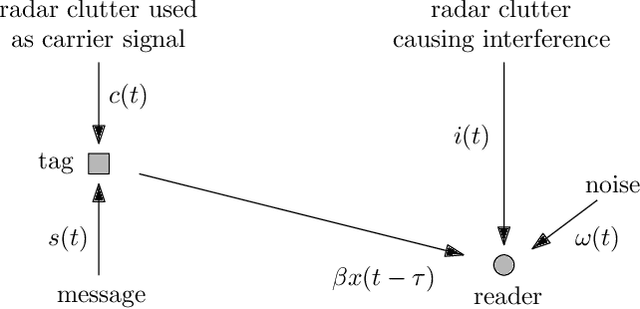


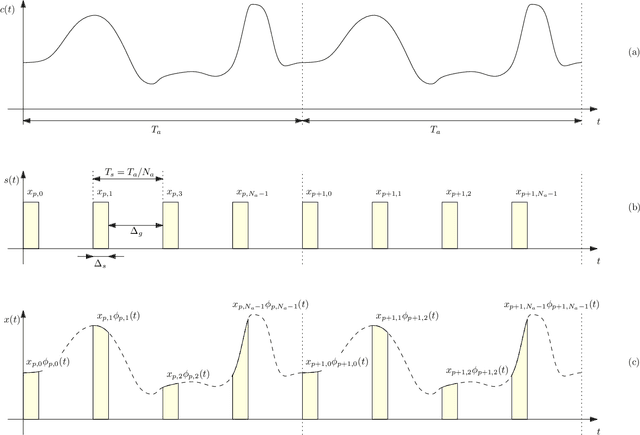
Abstract:In this work, we exploit the radar clutter (i.e., the ensemble of echoes generated by the terrain and/or the surrounding objects in response to the signal emitted by a radar transmitter) as a carrier signal to enable an ambient basckscatter communication from a source (tag) to a destination (reader). Upon deriving a convenient signal model, we exploit the fact that the radar clutter is periodic over time scales shorter than the coherence time of the environment, because so is the radar excitation, to distinguish the message sent by the tag from the superimposed ambient interference. In particular, we propose two encoding/decoding schemes that do not require any coordination with the radar transmitter or knowledge of the radar waveform. Different tradeoffs in terms of transmission rate and error probability can be obtained upon changing the control signal driving the tag switch or the adopted encoding rule; also, multiple tags can be accommodated with either a sourced or an unsourced multiple access strategy.
Subspace-Based Detection and Localization in Distributed MIMO Radars
May 18, 2022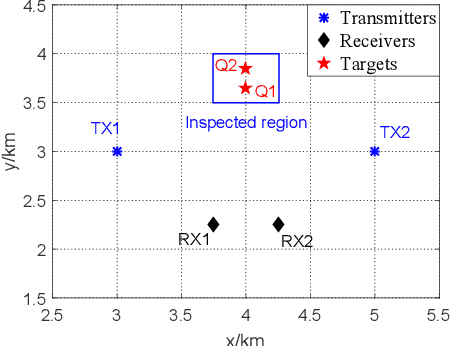
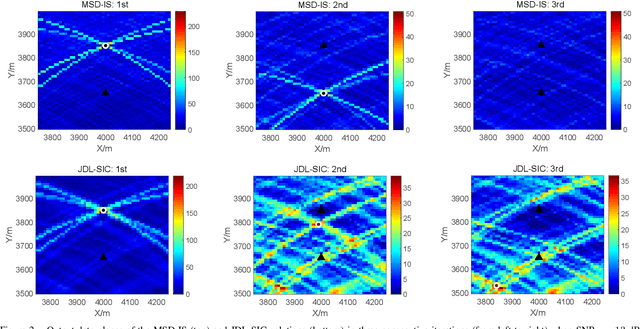
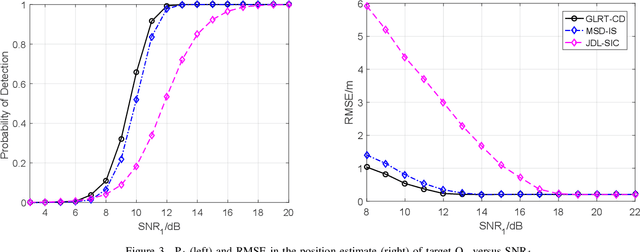
Abstract:In this paper, we consider a distributed multiple-input multiple-output (MIMO) radar which radiates waveforms with non-ideal cross- and auto-correlation functions and derive a novel subspace-based procedure to detect and localize multiple prospective targets. The proposed solution solves a sequence of composite binary hypothesis testing problems by resorting to the generalized information criterion (GIC); in particular, at each step, it aims to detect and localize one additional target, upon removing the interference caused by the previously-detected targets. An illustrative example is provided.
 Add to Chrome
Add to Chrome Add to Firefox
Add to Firefox Add to Edge
Add to Edge